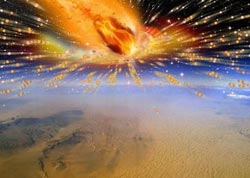First ever evidence of a comet striking Earth

This is an artist's rendition of the comet exploding in Earth's atmosphere above Egypt.<br>Credit: Terry Bakker<br>
The discovery has not only provided the first definitive proof of a comet striking Earth, millions of years ago, but it could also help us to unlock, in the future, the secrets of the formation of our solar system.
“Comets always visit our skies – they're these dirty snowballs of ice mixed with dust – but never before in history has material from a comet ever been found on Earth,” says Professor David Block of Wits University.
The comet entered Earth's atmosphere above Egypt about 28 million years ago. As it entered the atmosphere, it exploded, heating up the sand beneath it to a temperature of about 2 000 degrees Celsius, and resulting in the formation of a huge amount of yellow silica glass which lies scattered over a 6 000 square kilometre area in the Sahara. A magnificent specimen of the glass, polished by ancient jewellers, is found in Tutankhamun's brooch with its striking yellow-brown scarab.
The research, which will be published in Earth and Planetary Science Letters, was conducted by a collaboration of geoscientists, physicists and astronomers including Block, lead author Professor Jan Kramers of the University of Johannesburg, Dr Marco Andreoli of the South African Nuclear Energy Corporation, and Chris Harris of the University of Cape Town.
At the centre of the attention of this team was a mysterious black pebble found years earlier by an Egyptian geologist in the area of the silica glass. After conducting highly sophisticated chemical analyses on this pebble, the authors came to the inescapable conclusion that it represented the very first known hand specimen of a comet nucleus, rather than simply an unusual type of meteorite.
Kramers describes this as a moment of career defining elation. “It's a typical scientific euphoria when you eliminate all other options and come to the realisation of what it must be,” he said.
The impact of the explosion also produced microscopic diamonds. “Diamonds are produced from carbon bearing material. Normally they form deep in the earth, where the pressure is high, but you can also generate very high pressure with shock. Part of the comet impacted and the shock of the impact produced the diamonds,” says Kramers.
The team have named the diamond-bearing pebble “Hypatia” in honour of the first well known female mathematician, astronomer and philosopher, Hypatia of Alexandria.
Comet material is very elusive. Comet fragments have not been found on Earth before except as microscopic sized dust particles in the upper atmosphere and some carbon-rich dust in the Antarctic ice. Space agencies have spent billions to secure the smallest amounts of pristine comet matter.
“NASA and ESA (European Space Agency) spend billions of dollars collecting a few micrograms of comet material and bringing it back to Earth, and now we've got a radical new approach of studying this material, without spending billions of dollars collecting it,” says Kramers.
The study of Hypatia has grown into an international collaborative research programme, coordinated by Andreoli, which involves a growing number of scientists drawn from a variety of disciplines. Dr Mario di Martino of Turin's Astrophysical Observatory has led several expeditions to the desert glass area.
“Comets contain the very secrets to unlocking the formation of our solar system and this discovery gives us an unprecedented opportunity to study comet material first hand,” says Block.
Media Contact
More Information:
http://www.wits.ac.zaAll latest news from the category: Physics and Astronomy
This area deals with the fundamental laws and building blocks of nature and how they interact, the properties and the behavior of matter, and research into space and time and their structures.
innovations-report provides in-depth reports and articles on subjects such as astrophysics, laser technologies, nuclear, quantum, particle and solid-state physics, nanotechnologies, planetary research and findings (Mars, Venus) and developments related to the Hubble Telescope.
Newest articles

Peptides on Interstellar Ice
A research team led by Dr Serge Krasnokutski from the Astrophysics Laboratory at the Max Planck Institute for Astronomy at the University of Jena had already demonstrated that simple peptides…

A new look at the consequences of light pollution
GAME 2024 begins its experiments in eight countries. Can artificial light at night harm marine algae and impair their important functions for coastal ecosystems? This year’s project of the training…

Silicon Carbide Innovation Alliance to drive industrial-scale semiconductor work
Known for its ability to withstand extreme environments and high voltages, silicon carbide (SiC) is a semiconducting material made up of silicon and carbon atoms arranged into crystals that is…





















